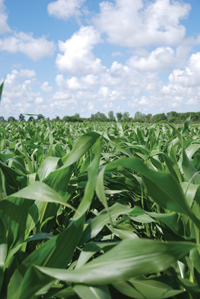
Features
Agronomy
Soil
Using climate patterns to predict corn yields
The power of computer modelling is becoming increasingly important in farming. It is proving helpful in predicting things like the spread of pests, diseases, pesticide resistance, even the effects of climate change.
February 24, 2010 By Treena Hein
 |
| The bulk of the research to link models predicting corn yields to weather patterns has been done in the United States, although there is no reason to believe growers in Canada would not find such modelling useful. Photo by Ralph Pearce. |
The power of computer modelling is becoming increasingly important in farming. It is proving helpful in predicting things like the spread of pests, diseases, pesticide resistance, even the effects of climate change.
Modelling is also helping producers with nutrient management. Researchers with the US Department of Agriculture’s Agricultural Research Service (USDA-ARS) have analyzed long-term climate patterns in order to predict corn yields, and have discovered that there is a basic pattern of low yield and high yield every second year.
In years that lower yields are expected, fertilizer application can be reduced. “The hope is that if farmers in the US Corn Belt can lessen fertilizer application in predicted low yield years, the flow of excess nitrate into watercourses and into the Gulf of Mexico will also be lessened,” says Rob Malone, an agricultural engineer at the USDA-ARS National Laboratory for Agriculture and the Environment in Ames, Iowa. “There is a substantial ‘hypoxic zone’ in the water there, partly resulting from too much nitrate. It’s a large environmental concern, as is excess nitrate runoff in Canada and many other parts of the world.”
In bigger yield years, small increases in crop N uptake from a bigger yield can result in substantial decreases in drainage N loss, notes Malone. “For example, we’ve determined that four percent greater crop N uptake can result in 30 percent less N in subsurface drainage in northeastern Iowa,” he says.
Malone, with laboratory director Dr. Jerry Hatfield and their colleagues, studied two climate phenomena that possibly contribute to the biannual weather patterns, the El Nino Southern Oscillation and the North Atlantic Oscillation. “Higher yields occur in years where these phenomena are correlated with higher surface radiation and lower temperature early in the corn growing season, with good rainfall later in the season,” says Malone.
The yield difference between high- and low-yielding years averages 19 percent. If the long-term pattern holds, Malone says 2010 will be a high-yield year in central Iowa, about seven percent higher than the long-term median yield.
Besides these effects of seasonal weather produced by climate phenomena, the researchers have also discovered another powerful additional factor limiting corn yield. “What our research shows,” says Hatfield, “is that N response and associated yield are dominated by water availability. We’ve found some of farmers’ lower yielding areas are water limited more than N limited.”
Hatfield found that in fields in the same year with the same N application rate, differences in yield could be attributed to the distribution of soil types. “Different soils provide different soil water availability, which is especially important during the grain-fill period of the growing season,” he says. Clarion soils (very deep, moderately well-drained upland soils) provided lower yields, and Webster soils (very deep, poorly drained, moderately permeable upland soils) produced higher yields. “This suggests that the availability of soil water should be considered by farmers as part of their nutrient management decisions,” says Hatfield. “They might also consider how they can increase soil water availability by boosting the percentage of organic material and by adopting soil management practices that reduce evaporation and runoff of water from the soil surface to increase the amount of water available to the plant.”
Computer and sensor power
Scientists at Cornell University in Ithaca, New York, are also using weather and climate data, this time to give corn growers guidance about how much N to side dress in-season.
The Adapt-N software is based on findings that soil N varies according to early season weather. Every day, data on temperature and precipitation from radar, satellites and ground stations are fed into the database. The modelling software then provides growers (who log in to the website and give their farm location) with recommendations to adjust N applications to more precisely match crop N demand. The program uses the application of well-calibrated and tested dynamic simulation models of soil N dynamics and crop N uptake, which account for changes in soil N.
“It’s currently functional for 13 states in the Northeastern US,” says Cornell Crop and Soil Science Department chair Dr. Harold van Es, who co-founded Adapt-N with Jeff Melkonian. “We’re currently working with researchers in Iowa to expand it there, and have had some interest in Indiana as well.” He says the modelling software can be hooked up with weather collection systems anywhere.
Ian Nichols, business manager at Weather INnovations (WIN) in Chatham, Ontario, says “I think this system would definitely be of interest here for farmers who side dress corn. Our weather program is ideally suited to deliver the results from this type of model for Canadian producers.”
Weather INnovations specializes in providing turnkey weather-based monitoring and modelling solutions for producer organizations, agencies and growers of specific commodities in the agricultural industry.
For more information, go online to:Adapt-N website:adapt-n.eas.cornell.edu
Weather INnovations www.weatherinnovations.com